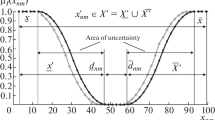Abstract
The article examines some algorithms for joint processing of raw data on the state of a complex multistage continuous production process to obtain probabilistic characteristics of abnormal critical events that can potentially lead to single failures or even emergencies. The article, thus, proposes and substantiates an approach to developing a technology to detect and predict malfunctions and determine their causes. The sequence of operations to process and convert diagnostic process data is considered essential. As a result, the article presents a general diagnostic model of a multistage production process. The model can formalize the main objects and processes in terms of the problem being solved. An incident is defined as an abnormal critical event described by non-normative values of diagnostic variables. Incidents are shown to be indicated by the corresponding membership functions. The hypotheses on potential incident causes are discussed to be built with belief functions being the basis of evidence theory or Dempster–Shafer theory. The hypotheses are characterized by an interval of malfunction probability in some process chain. The authors propose a procedure of converting these hypotheses into fuzzy production rules automatically. The automatical procedure is a prerequisite to using fuzzy neural networks to obtain a reliable estimate of the degree of belief in the incident cause. As a summary, the generated database of the production rules to train a neural network is substantiated to be used with the TSK architecture that makes possible to estimate a malfunction probability in the process chain quickly without resource-intensive computations.


Similar content being viewed by others
REFERENCES
V. K. Ivanov and B. V. Palyukh, ‘‘Joint use neural networks and evidence theory methods in control and diagnostic fuzzy systems,’’ Iskusstv. Intell. Prinyat. Reshen. 4, 75–88 (2021). https://doi.org/10.14357/20718594210407
A. P. Dempster, ‘‘A generalization of Bayesian inference,’’ J. R. Stat. Soc., Ser. B 30, 205–247 (1968).
G. A. Shafer, Mathematical Theory of Evidence (Princeton Univ. Press, Princeton, NJ, 1976).
D. T. Hoang and K. J. Kang, ‘‘A bearing fault diagnosis method using transfer learning and Dempster–Shafer evidence theory,’’ in Proceedings of the International Conference on Artificial Intelligence, Robotics and Control AIRC (2019), pp. 33–38. https://doi.org/10.1145/3388218.3388220
M. Itkina, K. Driggs-Campbell, and M. J. Kochenderfer, ‘‘Dynamic environment prediction in urban scenes using recurrent representation learning,’’ in Proceedings of the IEEE Intelligent Transportation Systems Conference ITSC (2019), pp. 2052–2059. https://doi.org/10.1109/ITSC.2019.8917271
M. J. Kochenderfer and M. Mikhal, ‘‘Convolutional neural network information fusion based on dempster-shafer theory for urban scene understanding,’’ Technical Report (Stanford Univ., 2017), pp. 4321–4328. http://cs231n.stanford.edu/reports/2017/pdfs/632.pdf. Accessed April 17, 2022.
T. Denoeux, ‘‘Logistic regression, neural networks and Dempster-Shafer theory: A new perspective,’’ Knowledge-Based Syst. 176, 54–67 (2019). https://doi.org/10.1016/j.knosys.2019.03.030
Z. Tong, P. Xu, and T. Denoeux, ‘‘ConvNet and Dempster-Shafer theory for object recognition,’’ in Proceedings of the 13th International Conference on Scalable Uncertainty Management (2019), pp. 368–381. https://doi.org/10.1007/978-3-030-35514-2_27
C. Gao, F. Wang, and D. Xu, ‘‘Gas outburst prediction based on the intelligent Dempster-Shafer evidence theory,’’ in Proceedings of the 9th International Conference on Modelling, Identification and Control ICMIC (2017), pp. 897–901. https://doi.org/10.1109/ICMIC.2017.8321582
L. Li, J. Tang, and Y. Liu, ‘‘Partial discharge recognition in gas insulated switchgear based on multi-information fusion,’’ IEEE Trans. Dielectr. Electr. Insul. 22, 1080–1087 (2015). https://doi.org/10.1109/TDEI.2015.7076809
S. Saha, S. Saha, and P. P. Bhattacharyya, ‘‘Classifier fusion for liver function test based Indian Jaundice classification,’’ in Proceedings of the International Conference on Man and Machine Interfacing MAMI (2015), pp. 1–6. https://doi.org/10.1109/MAMI.2015.7456588
Y. Chen, Y. Yang, J. Li, et al., ‘‘Intelligent fault diagnosis technology based on hybrid algorithm,’’ in Proceedings of the Chinese Control and Decision Conference CCDC (2016), pp. 3702–3706. https://doi.org/10.1109/CCDC.2016.7531627
S. A. Kalmykov, Y. I. Shokin, and Z. H. Yuldashev, Interval Analysis Methods (Nauka, Novosibirsk, 1986) [in Russian]. http://www.nsc.ru/interval/Library/InteBooks/KalmShokYuld.djvu. Accessed April 17, 2022.
S. P. Sharyi, Finite-Dimensional Interval Analysis (XYZ, Novosibirsk, 2022) [in Russian]. http://www.nsc.ru/interval//Library/InteBooks/SharyBook.pdf. Accessed April 17, 2022.
R. Yager and L. Liping, Classic Works of the Dempster-Shafer Theory of Belief Functions (Springer, London, 2010).
B. V. Palyukh, V. K. Ivanov, and A. N. Sotnikov, ‘‘Evidence theory for complex engineering system analyses,’’ Adv. Intell. Syst. Comput. 874, 70–79 (2019). https://doi.org/10.1007/978-3-030-01818-4_7/
V. K. Ivanov, I. V. Obrazcov, and B. V. Palyukh, ‘‘Implementing an expert system to evaluate technical solutions innovativeness,’’ Progr. Produkty Sist. 4 (26), 696–707 (2019). https://doi.org/10.15827/0236-235X.128.696-707
P. Walley, ‘‘Inferences from multinomial data: Learning about a bag of marbles,’’ J. R. Stat. Soc., Ser. B 1 (58), 3–34 (1996). https://doi.org/10.1111/j.2517-6161.1996.tb02065.x
T. Denoeux, ‘‘Constructing belief functions from sample data using multinomial confidence regions,’’ Int. J. Approx. Reason. 3 (42), 228–252 (2006). https://doi.org/10.1016/j.ijar.2006.01.001
A. Aregui and T. Denoeux, ‘‘Constructing consonant belief functions from sample data using confidence sets of pignistic probabilities,’’ Int. J. Approx. Reason. 3 (49), 575–594 (2008). https://doi.org/10.1016/j.ijar.2008.06.002
K. Sentz and S. Ferson, ‘‘Combination of evidence in Dempster–Shafer theory,’’ Report SAND 2002-0835 (Sandia Natl. Labor., 2002).
A. E. Lepskiy, ‘‘Analysis of information inconsistency in belief function theory. Part I: External conflict,’’ Control Sci. 5, 2–16 (2021). https://doi.org/10.25728/cs.2021.5.1
V. K. Ivanov and B. V. Palyukh, ‘‘A software platform demonstrator for joint use of evidence theory algorithms and neural networks in fuzzy systems,’’ Program. Produkty Sist. 4 (34), 511–523 (2021). https://doi.org/10.15827/0236-235X.136.511-523
J. S. R. Jang, ‘‘ANFIS: Adaptive-network-based fuzzy inference system,’’ IEEE Trans. Syst. Man Cybern. 3 (23), 665–685 (1993). https://doi.org/10.1109/21.256541
A. Cai, C. Quek, and D. L. Maskell, ‘‘Type-2 GA-TSK fuzzy neural network,’’ in Proceedings of the 2007 IEEE Congress on Evolutionary Computation (2007), pp. 1578–1585. https://doi.org/10.1109/CEC.2007.4424661
Funding
This work was done at the Tver State Technical University with supporting of the Russian Foundation of Basic Research (project no. 20-07-00199) and at the JSCC RAS as part of the government assignment (topic FNEF-2022-0016). Supercomputer MVS-10P was used in research.
Author information
Authors and Affiliations
Corresponding authors
Additional information
(Submitted by A. M. Elizarov)
Rights and permissions
About this article
Cite this article
Ivanov, V.K., Palyukh, B.V. & Sotnikov, A.N. Generation of Production Rules with Belief Functions to Train Fuzzy Neural Network in Diagnostic System. Lobachevskii J Math 43, 2853–2862 (2022). https://doi.org/10.1134/S1995080222130169
Received:
Revised:
Accepted:
Published:
Issue Date:
DOI: https://doi.org/10.1134/S1995080222130169




